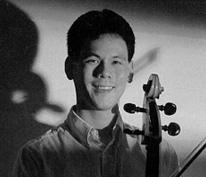ICS EXCLUSIVE INTERVIEW
 | CONVERSATION WITHby TIM FINHOLT |
 | CONVERSATION WITHby TIM FINHOLT |
Bion Tsang has appeared as soloist with the New York, Moscow, and Hong Kong Philharmonic Orchestras, the National, American, Atlanta, and Pacific Symphony Orchestras, the Stuttgart Chamber Orchestra, and the Taiwan National Orchestra. Mr. Tsang's career as a chamber musician has been equally distinguished, marked by numerous collaborations with violinists Cho-Liang Lin and Pamela Frank, frequent appearances as guest artist of the Boston Chamber Music Society, and performances at festivals such as Marlboro Music, the Portland and Seattle Chamber Music Festivals, and the Laurel Festival of the Arts, where he serves as Artistic Director.
TF: You have been a soloist with several orchestras. What did you need to learn in order to become an effective soloist?
BT: Well, this is an ongoing learning process. The most difficult thing is the fact that all orchestras are different, especially at this stage of my career. I play with orchestras at many different skill levels, which can be a real adventure. With each orchestra I have to assess how much I can lead versus how much I have to follow, simply because the orchestra may not be able to follow me. I'm constantly trying to determine how much freedom I have. This is the most difficult aspect of being a soloist for me.
TF: What lessons have you learned about connecting with the audience?
BT: Before you can connect with the audience you have to be heard. So I work a lot on projection. When you play in recital you can always tell the pianist to put the lid down. It's not that simple when playing with an orchestra. Orchestras can only play so softly, even the best ones.
TF: You are both a soloist and a chamber musician. How does your playing change when you switch between solo and chamber music?
BT: Much more blending is required in chamber music. In a sense, chamber music is easier since you're not in the spotlight the whole time. When you play solo, even if you're playing an accompaniment, all eyes and ears are on you. Soloing takes much more concentration. That's not to say that I don't concentrate when I play chamber music, it's just very different. I think more about blending with and supporting the other chamber musicians, and about how to bring out the structure and harmonies of the piece....
TF: What kind of playing do you not like?
BT: One of my pet peeves is the excessive use of portato, when there is a small dip in sound between slurred notes. I love hearing a smooth line, where the bowing is smooth and the articulation is done only with the left hand. I don't like it when a musician tries to create a sense of legato by layering instead of sustaining and playing through a line. I don't mean that portato should never be used. It should be used consciously, not out of habit.
TF: Do you have any pet peeves in performances of the Bach cello suites?
BT: No, I'm very open to different ideas on Bach. My favorite interpretation is definitely Casals'. I lean towards his approach when I perform them. I can appreciate just about any performance as long as it's convincing and it brings out the structure of the piece.
TF: As you know, Casals came from a very different era. His playing reflects the "sound-world" in which he lived, a more Romantic time. Would you say that you love Casals' approach to Bach, but that you wouldn't want to play like him?
BT: I would love to play like him, and I hope that my playing reminds people of that era. I love his style of playing and I hope that it is a part of me.
I've had other models besides Casals. My other main influence was Rostropovich, because my father loved him and bought a lot of his recordings. My dad would drive me every Saturday to Juilliard, a 90 minute drive, and there would always be a tape playing in the car.
Rostropovich's approach is on a much grander scale than Casals', not that Casals didn't see the big picture. Rostropovich is always thinking in terms of large chunks and the larger phrase, which I try to emulate in my own playing. Casals dwelled more upon the intricate details of each note and phrase. So I try to incorporate both Casals' and Rostropovich's approach. I try to play music on as many different levels as possible so that a phrase will be unending in a sense, while still bringing out the small phrases. Like a great painting, the music should be beautiful from far away, and retain its beauty as you get closer and closer, even when you see the fine details.
Casals never lost sight of the big picture. But I think he was so earnest about teaching every little detail that people often lost sight of the wider view. People get caught up in the details when they listen to him play. But I think if you were to analyze his recordings you would find that he had a grand vision. For example, if you were take a decibel reading of his interpretation of Bach, you would probably find that the loudest point would be the climax of the entire piece.
Learn more about Bion Tsang, and hear him perform at his website: http://www.biontsang.com
![[Picture]](ics4.gif) |
Direct correspondence to the appropriate ICS
Staff Webmaster: webmaster Director: John Michel Copyright � 1995-97 Internet Cello Society |
|---|